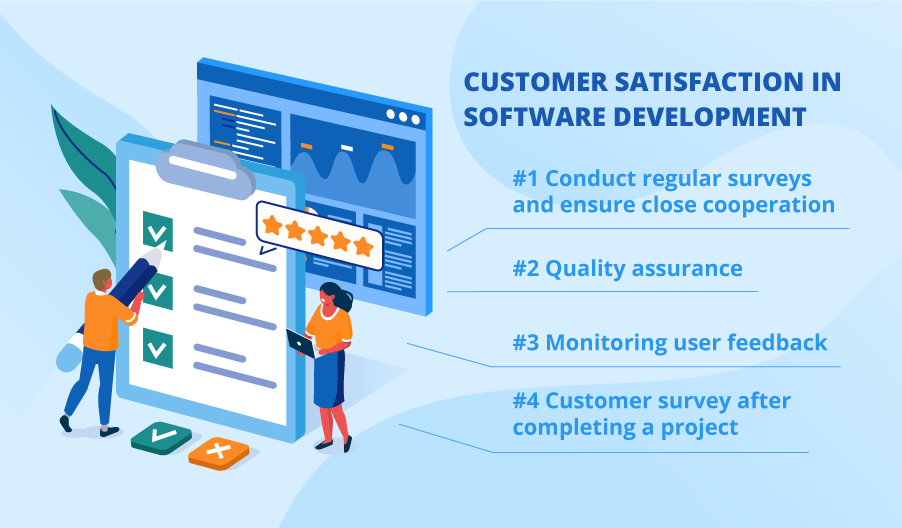How to Measure and Ensure Customer Satisfaction in Software Development Industry
Grateful testimonials from clients are a sign that your business is rolling and growing. But feedback is not the only indicator of the level of customer satisfaction. There are other ways of turning clients into loyal and avoiding drawbacks in software development services.

Customer satisfaction and product quality
These terms are often mistakenly equated. In fact, when a client doesn’t feel good about the results of cooperation, it doesn’t necessarily mean a delivered product is of low quality. There are so many factors that are able to influence customers’ opinion on partnering with a software development company.
For instance, IT engineers managed to create an outstanding application but failed to deliver it in time, and communication with a client wasn’t smooth enough. These issues can result in an unfavorable impression regardless of an excellent software solution. Thus, a high-quality product isn’t the only factor to ensure customers’ positive testimonials and references.
What are the tips for increasing customer satisfaction?
The best way to keep customers satisfied is to complete work within the time frame, meet the budget, and develop a great product at the end. In words it seems a piece of cake but what about in practice? What exactly you should do to win clients’ loyalty? To find the answers, you have to dive into the peculiarities of measuring customer satisfaction.
1. Conduct regular surveys and ensure close cooperation
Make this a habitual daily part of your project plan. Ask more questions during meetings and video-conferences to gather sufficient information about the client’s expectations. This simple method allows detecting a problem before its actual occurrence. You can also challenge your company’s quality manager to draw up a list of questions to quickly understand whether a client is happy with a service or not.
Use case #1
One of our clients was very anxious about meeting the project deadline. He depended on his investors and was afraid that a project wouldn’t be finished on time. Thanks to regular monitoring and close cooperation with a development team our quality manager kept the situation under control. At the earliest opportunity, we invited more developers to work on the project. It allowed us to cut the project timeline without increasing a project workload and breaking a budget. We managed to deliver the solution ahead of schedule, and the customer was more than satisfied with the result.
2. Quality assurance
Bring your quality management system in line with ISO 9001:2000 standard. It allows monitoring of the products quality, services, and other processes in an IT company. Credible information about the real quality of the company’s services and products helps flexibly manage production processes, monitor and resolve problem cases, and avoid the same mistakes in the future. Day-to-day quality monitoring helps objectively evaluate the level of services. Impeccable quality assurance in a software development company results in the following advantages:
- A customer willingly accepts the outcome of developers’ work.
- A software services provider deals with no complaints on quality of a product and services.
- There is no need to spend additional resources to correct mistakes which appear after an app/system launch.
3. Monitoring user feedback
It’s important to constantly monitor the fate of a solution, even if a client is a product owner and takes care of further project development and promotion. It’s the task for a marketing department to gather end-user reviews and analyze them. Collecting this information allows understanding users’ attitude towards a software application and a company which created this solution.
Use case #2
Our customer aka product owner applied for the development of a new app version for iTunes and Play market. Owing to a large number of user reviews, our business analyst managed to define user requirements which formed the basis of a project development plan.
4. Customer survey after completing a project
To get the full picture of customers’ attitude to service quality, it’s better to use not only one questionnaire but a complex of them.
- Customer Satisfaction Score (CSAT) is one of the most popular methods of measuring customer satisfaction. Ask clients to rate the quality of the services they received from your company, e.g. by giving points from 1 to 10.
- Customer Effort Score (CES) is a survey allowing you to find out client’s overall impression about working with you. Ask “how easy was it to solve your problem with our assistance?” and provide possible answers.
- Net Promoter Score (NPS) helps to understand how loyal a customer is. Create a survey with a question similar to “how likely is that you will recommend our company to somebody?”. This is how you will define the clients who will probably come back to you with new projects.
Conclusion
To ensure the high level of customers’ satisfaction, you should always keep an eye on quality assurance, ask questions, and support close cooperation with a client. In this case, you can be sure that you are on the same page with your clients and know exactly what they need.

